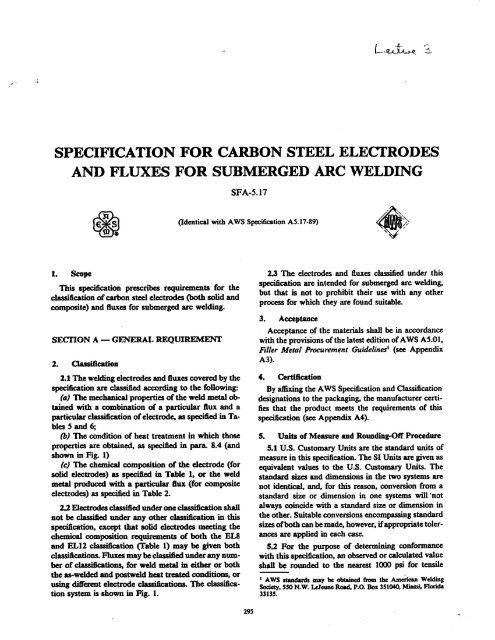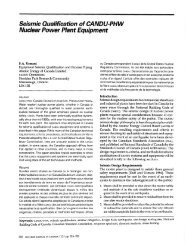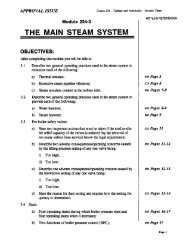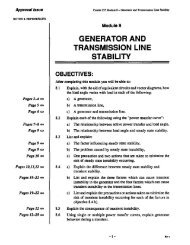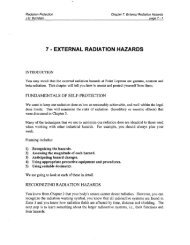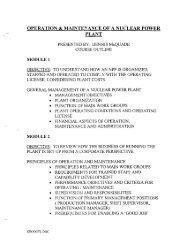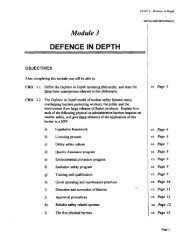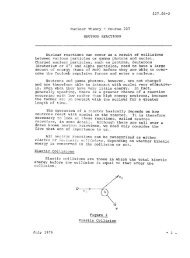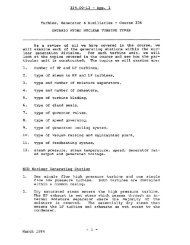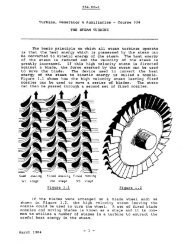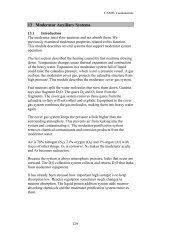SPECIFICATION FOR CARBON STEEL ELECTRODES ... - Canteach
SPECIFICATION FOR CARBON STEEL ELECTRODES ... - Canteach
SPECIFICATION FOR CARBON STEEL ELECTRODES ... - Canteach
You also want an ePaper? Increase the reach of your titles
YUMPU automatically turns print PDFs into web optimized ePapers that Google loves.
<strong>SPECIFICATION</strong> <strong>FOR</strong> <strong>CARBON</strong> <strong>STEEL</strong> <strong>ELECTRODES</strong><br />
AND FLUXES <strong>FOR</strong> SUBMERGED ARC WELDING<br />
1. Scope<br />
r{D m.<br />
This specification prescribes requirements for the<br />
classification ofcarbon steel electrodes (both solid and<br />
composite) and fluxes for submerged arc welding.<br />
SECflON A - GENERAL REQUIREMENT<br />
2. Classification<br />
2.1 The welding electrodes and fluxes covered by the<br />
specification are classified according to the following:<br />
(a) The mechanical properties ofthe weld metal obtained<br />
with a combination of a particular flux and a<br />
particular classification ofelectrode, as specified in Tables<br />
5 and 6;<br />
(b) The condition of heat treatment in which those<br />
properties are obtained, as specified in para. 8.4 (and<br />
shown in Fig. I)<br />
(c) The chemical composition of the electrode (for<br />
solid electrodes) as specified in Table I, or the weld<br />
metal produced with a particular Oux (for composite<br />
electrodes) as specified in Table 2.<br />
2.2 Electrodes classified underoneclassification shall<br />
not be classified under any other classification in this<br />
specification, except that solid electrodes meeting the<br />
chemical composition requirements of both the EL8<br />
and ELI2 classification (Table I) may be given both<br />
classifications. Fluxesmaybeclassified underany number<br />
of classifications, for weld metal in either or both<br />
the as-welded and poslweld heat treated conditions, or<br />
using ditl'erent electrode classifications. The classification<br />
system is shown in Fig. 1.<br />
SFA-5.17<br />
(Identical with AWS Specification AS.17·89)<br />
295<br />
2.3 The electrodes and fluxes classified under this<br />
specification are intended for submerged arc welding,<br />
but that is not to prohibit their use with any other<br />
process for which they are found suitsble.<br />
3. Acceptance<br />
Acceptance of the materials shall be in accordance<br />
with the provisions ofthe latest edition ofAWS AS.OI,<br />
Filler Metal Procurement Guidelines' (see Appendix<br />
A3).<br />
4. CertIfication<br />
By affixing the AWS Specification and Oassification<br />
designations to the packaging, the manufacturer certifies<br />
that the product meets the requirements of this<br />
specification (see Appendix A4).<br />
5. Units of Measure and Rounding.()ff Procedure<br />
5.1 U.S. Customary Units are the standard units of<br />
measure in this specification. The Sl Units are given as<br />
equivalent values to the U.S. Customary Units. The<br />
standard sizes and dimensions in the two systems are<br />
not identical, and, for this reason, convenion from a<br />
standard size or dimension in one systems will 'not<br />
always coincide with a standard size or dimension in<br />
the other. Suitable conversions encompassing standard<br />
sizes ofboth can be made, however, ifappropriate tolerances<br />
are applied in each case.<br />
5.2 For the purpose of determining conformance<br />
with this specification, an observed or calculated value<br />
shall be rounded to the nearest 1000 psi for tensile<br />
tAWS standards may be obtained (rom the American Welding<br />
Society.''11 N.W. LcJeune1lold, P.O. Bo. 3'1040. Miami, Florida<br />
33m.
PART C - SPECIACATIONS <strong>FOR</strong> WELDING RODS.<br />
<strong>ELECTRODES</strong>, AND ALLER METALS SFA·5.17<br />
"; TABLE 1<br />
CHEMICAL COMPOSmON REQUIREMENTS <strong>FOR</strong> SOUD <strong>ELECTRODES</strong><br />
wt. ptreentlU W<br />
Electrode UNS<br />
Classification Numbe,o' C Mn Si S P Cit"<br />
law Manganese Electrodes<br />
ELS KOI008 0.10 0.25/0.1>0 0.07 0.030 0.030 0.35<br />
ELSK KOIOll'l 0.10 0.25/0.1>0 0.10/0.25 0.030 0.030 0.35<br />
ELl2 KOIOl2 0.04/0.14 0.25/0.60 0.10 0.030 0.030 0.35<br />
Medium Manganese Electrodes<br />
EMI2 KOUI2 0.06/0.15 0.80/1.25 0.10 0.030 0.030 0.35<br />
EMI2K KOU13 0.05/0.15 0.80/1.25 0.10/0.35 0.030 0.030 0.35<br />
EM13K K01313 0.06/0.16 0.90/1.40 0.35/0.75 0.030 0.030 0.35<br />
EMI4K K01314 0.06/0.19 0.90/1.40 0.35/0.75 0.025 0.025 0.35<br />
1TI 0.03/0.17)<br />
EMI5K KOl515 0.10/0.20 0.80/1.25 0.10/0.35 0.030 0.030 0.35<br />
Higll Manganese Electrodes<br />
EHUK KUI40 0.07/0.15 1.40/1.85 0.80/1.15 0.030 0.030 0.35<br />
EHI2K K01213 0.06/0.15 1.50/2.00 0.25/0.65 0.025 0.025 0.35<br />
EHI4 KU585 0.10/0.20 1.70/2.20 0.10 0.030 0.030 0.35<br />
NOTES:<br />
(1) The filler metal shall be analyzed for the specific elements for which values are shown in this table. If the presence of ot."er elements is<br />
indicated, in the course of this work, the amount of those elements shall be determined to ensure that their total (excluding iron) does<br />
not exceed 0.50 percent.<br />
(2) Single values are maximum.<br />
(3) SAE/ASTM Unified Numbering SyStem for Metals and Alloys.<br />
(4) The copper limit Includes any copper coating that may be applied to the electrode.<br />
7. Retest<br />
Ifany test fails to meet its requirement, that test shall<br />
be repeated twice. The results ofboth tests shall meet<br />
the requirement. Samples for retest may be taken from<br />
the original test assembly or from one or two new test<br />
ECI<br />
TABLE 2<br />
CHEMICAL COMPOSmON REQUIREMENTS <strong>FOR</strong><br />
COMPOSITE ELECTRODE WELD METAL<br />
Electrode<br />
Classification<br />
C<br />
Mn Sf S P<br />
0.15 1.80 0.90 0.035 0.035 0.35<br />
NOTES:<br />
(l) The weld metal shall be analyzed for the specific elements for<br />
which values are shown in this table. [f the presence of other<br />
elements Is Indicated, In the course of this work, the amount<br />
of those elements shall be determined to ensure that their total<br />
(excluding Iron) does not exceed 0.50 percent.<br />
(2) Single values maximum.<br />
(3) A low dilution a of the groove weld of Rg. 3 or the fractured<br />
tension test specimen of FIg. 5 ...., be substituted for<br />
the weld pad, and shall meet the above requirements. In case<br />
of dispute. the weld pad shall be the referee method.<br />
297<br />
assemblies. For chemical analysis. retest need be only<br />
for those specific elements that failed to meet their<br />
requirement.<br />
8. Weld Test AssembUes<br />
8.1 No weld test assemblies are required for classilication<br />
of solid electrodes. One weld test assembly is<br />
required for classification ofcomposite electrodes. It is<br />
the weld pad in FIg. 2 for chemical analysis ofthe low<br />
dilution weld metal.<br />
In addition to the above, one weld test assembly<br />
is required for each classification of an electrode-flux<br />
combination. This is the groove weld in Fig. 3 for mechanical<br />
properties and soundness of the weld metal.<br />
Note (3) to Table 2 allows the sample for chemical<br />
analysis in the case ofa composite electrode to be taken<br />
from a low dilution area in the groove weld, FIg. 3. or<br />
from the fractured tension test 8pecimen, FIg. S. thereby<br />
avoiding the need to make the weld pad. In case of<br />
dispute, the weld padshall be the referee method. When<br />
a Certificate ofTest is prepared, it shall indicate wheth-
metal. Both surfaces of the test assembly, in the area<br />
ofthe weld, shall be smooth enough to avoid di1Iiculty<br />
in interpreting the radiograph.<br />
10.2 The weld shall be radiographed in accordance<br />
with ASTM method E 142 Controlling Quality ofRadiogrrzphk<br />
Testing. The quality level ofinspection shall<br />
be 2-2T.<br />
10.3 The soundness of the weld metal meets the requirements<br />
ofthis specification ifthe radiograph does<br />
not show:<br />
(a) Cracks, incomplete fusion, or incomplete penetration;<br />
(b) Slag inclusions longer than y. in. (6 mm) or Y, of<br />
the thickness of the weld, whichever is greater, or<br />
groups ofslag inclusions in line that have an aggregate<br />
length greater than the thickness ofthe weld in a length<br />
12 times the thickness of the weld except when the<br />
distance between the successive inclusions exceeds six<br />
times the length of the longest inclusion in the group.<br />
(e) Rounded indications in excess ofthose permitted<br />
by the radiographic standards in Fig. 4.<br />
One inch ofthe weld, measured from each end ofthe<br />
test assembly, shall be disregarded from radiographic<br />
evaluation.<br />
11. Tension Test<br />
11.1 One all-weld-metal tension test specimen shall<br />
be machined from the groove weld described in para.<br />
8.4 and shown in Fig. 3. The dimensions of the speci.<br />
men shall be as shown in Fig. S.<br />
11.2 The specimen shall be tested in the manner<br />
described in the tension test section ofthe latest edition<br />
ofANSIIAWS B4.0, Standard Me/hodsfar Mechanical<br />
Testing of Welds.<br />
11.3 The results of the tension test shall meet the<br />
requirements specified in Table S.<br />
12. Impact Test<br />
12.1 Five Charpy V-notch impact specimens (Fig. 6)<br />
shall be machined from the test assembly shown in Fig.<br />
3 for those classifications for which impact testing is<br />
required in Table 6.<br />
12.2 The five specimens shall be tested in accordance<br />
with the impact test section of ANSIIAWS B4.0. The<br />
test temperature shall be that specified in Table 6 for<br />
the classification under test.<br />
12.3 In evaluating the test results, the lowest and the<br />
highest values obtained shall be disregarded. Two of<br />
PART C - SPECIACATIONS RlR WELDING RODS.<br />
<strong>ELECTRODES</strong>. AND ALLER METALS SFA·5.17<br />
J01<br />
the remaining three values shall equal, or exceed, the<br />
specified 20 ft·lb (27 1) energy level. One of the three<br />
may be lower, but not lower than IS ft·lbs (201), and<br />
the average of the three shall not be less than the required<br />
20 ft·lb (27 1) energy level.<br />
SECrION C - MANUFACI'URE,<br />
IDENTJFICATION AND PACKAGING<br />
13. Method of Manufacture<br />
The electrodes and flues classified according to this<br />
specification may be manufactured by any method that<br />
will produce material that meets the requirements of<br />
this specification.<br />
14. Electrode Requirements<br />
14.1 Standard Sizes. Standard sizes for electrodes in<br />
the different package forms (coils with support, coils<br />
without support, and drums) are shown in Table 7.<br />
14.2 Finish and Uniformity<br />
14.2.1 The electrode shall have a smooth finish<br />
which is free from slivers, depressions, scratches, scale,<br />
seams and laps (exclusive of the longitudinal joint in<br />
composite electrodes), and foreign matter that would<br />
adversely afl'ect the welding characteristics, the operation<br />
ofthe welding equipment, or the properties ofthe<br />
weld metal.<br />
14.2.2 A Each continuous length ofelectrode shall<br />
be from a single heat or lot ofmaterial, and welds, when<br />
present, shall have been made so as not to interfere with<br />
the uniform, uninterrupted feeding of the electrode on<br />
automatic and semiautomatic equipment.<br />
14.2.3 Core ingredients in composite electrodes<br />
shall be distributed with sufficient uniformity throughout<br />
the length of the electrode so as not to adversely<br />
afl'ect the performance ofthe electrodeor the properties<br />
of the weld metal.<br />
14.2.4 A suitable protective coating, such as copper,<br />
may be applied to any electrode covered in this<br />
specification.<br />
14.3 Standard Package Forms<br />
14.3.1 Standard package forms are coils with support,<br />
coils without support, and drums. Standard package<br />
dimensions and weights for each form are given in<br />
Table 8. Package forms, sizes and weights other than<br />
theseshall beasagreed between purchaserand supplier.
• Wear correct eye, ear and body protection.<br />
• Do not touch live electrical parts.<br />
• See American National Standard Z49.1. Sofety in<br />
Welding and Cutting, published by the American<br />
Welding Society. 550 N.W. LeJeune Road, P.O.<br />
Box 351040, Miami, Florida 33135; OSHA Safety<br />
PART C - SPECIACAll0NS <strong>FOR</strong> WELDING RODS.<br />
<strong>ELECTRODES</strong>, AND AUER METALS SFA-S.17<br />
307<br />
and Health Standards, 29 CFR 1910, available<br />
from the U.S. Government Printing Office, Washington,<br />
DC 20402<br />
DO NOT REMOVE THIS LABEL
Appendix<br />
Guide to ANSI/AWS AS.17-89, Specification for Carbon<br />
Steel Electrodes and Fluxes for Submerged Arc Welding<br />
(Ibis AppendiJI is not a part ofANSI!AWS AS.17-S9, speci/iCJJtion for Qubon Steel Elet:ttodes and F7wces for Submerged<br />
An: Welding, but is included for information purposes only.)<br />
At. introduction<br />
The purpose ofthis guide is tocorrelale the electrode<br />
and flux classification with their intended applications<br />
so the specification can be used etrectively. Reference to<br />
appropriate base metal specifications is made whenever<br />
that can be .done and when it would be helpful. Such<br />
references are intended only as examples rather than<br />
complete listings of the base metals for which each<br />
electrode and flux combination is suitable.<br />
Al. Oassificatlon System<br />
Al.t Oasslficatlon of Electrodes. The system for<br />
identifying the electrode classifications in this specifications<br />
follows the standard patlem used in other AWS<br />
filler metal specifications. The letter "E" at the beginning<br />
of each classification designation stands for electrode.<br />
The remainder of the designation indicates the<br />
chemical composition of the electrode, or, in the case<br />
ofcomposite electrodes, ofthe low dilution weld metal<br />
obtained with a particular flux. See Fig. 1.<br />
The letter "L" indicates that the solid electrode is<br />
comparatively low in manganese conlent. The letter<br />
uM" indicates a medium manganese content, while the<br />
letter "H" indicates a comparatively high manganese<br />
content. The one or two digits following the manganese<br />
designator indicale the nominal carbon content of the .<br />
electrode. The letter"K", which appears in somedesignations,<br />
indica1eS that theelectrode is madefrom a heat<br />
ofsilicon-killersteel. Solidelectrodes are classified only<br />
on the basis oftheir chemica! composition, as specified<br />
in Table I of this specification.<br />
309<br />
A composite electrode is indica1ed by the letler "C"<br />
after the "E", and a numerical sullix. The composition<br />
ofa composile electrode is meaningless and the user is<br />
therefore referred to weld metal composition (Table 2)<br />
with a particular flux, rather than to electrode composition.<br />
Al.2 Oasaificatlon of Fluxes. Fluxes are classified<br />
on the basis of the mechanical properties of the weld<br />
metal they produce with some certain classification of<br />
electrode, under the specific test conditions called for<br />
in Section B of this specification.<br />
As examples of flux classifications, consider the following:<br />
F6AO-EH14<br />
F7P6-EMI2K<br />
F7P4-ECI<br />
The prefix "F' designates a flux. This is followed by<br />
a single digit representing the minimum tensile strength<br />
required of the weld metal in 10 000 psi increments.<br />
When the letter "A" follows the strength designator,<br />
it indicates that the weld metal was tested (and is classified)<br />
in the as-welded condition. When the letter "P"<br />
follows the strength designator, it indicates that the<br />
weld metal was tested (and is classified) after postweld<br />
heat treatment called for in the specification. The digit<br />
that follows the A or P will be a number or the letter<br />
"Z". This digit refers to the impact strength ofthe weld<br />
metal. Specifically, it designales the Iemperature at<br />
(and above) which the weld metal meets, or exceeds,<br />
the required 20 ft-lb (27 J) Charpy V-notch impact<br />
strength (except for the letler Z. which indica1eS that<br />
no impact requirement is specified - see Table 6).<br />
These mechanical property designations are followed
weld metal chemical analysis as a result of a large<br />
change in the arc voltage, and thus, the arc length.<br />
The primary use for neutral fluxes is in multiple pass<br />
welding, especially when the base metal exceeds I in.<br />
(25 mm) in thickness.<br />
Note the following considerations concerning neutral<br />
fluxes:<br />
(a) Since neutral fluxes contain little or no deoxidizen,<br />
they must rely on the electrode to provide deoxidation.<br />
Single pass welds with insuflicient deoxidation on<br />
heavily oxidized base metal may be prone to porosity,<br />
centerline cracking, or both.<br />
(b) While neutral fluxes do maintain the chemical<br />
composition of the weld metal even when the voltage<br />
is change, itis notalways truethatthechemical composition<br />
of the weld metal is the same as the chemical<br />
composition ofthe electrode used. Some neutral fluxes<br />
decompose in the heat of the arc and release oxygen,<br />
resulting in a lower carbon value in the weld metal than<br />
the carbon content ofthe electrode itself. Some neutral<br />
fluxes contain manganesesilicate which can decompose<br />
in the heat of the arc to add some manganese and<br />
silicon to the weld metal even though no metallic manganese<br />
or silicon was added to these particular fluxes.<br />
These changes in the chemical composition ofthe weld<br />
metal are fairly consistent even when there are large<br />
changes in voltage.<br />
(c) Even when a neutral flux is used to maintain the<br />
weld metal chemical composition through a range of<br />
welding voltages, weld properties such as strength level<br />
and impact properties can change because of changes<br />
in other welding parameters such as depth of fusion,<br />
heat input, and number of passes.<br />
A6.1.2 Active Fluxes. Active fluxes are those<br />
which contain small amounts ofmanganese, silicon, or<br />
both. These deoxidizers are added to the flux to provide<br />
improved resistance to porosity and weld cracking<br />
caused by contaminants on or in the base metal.<br />
The primary use for active fluxes is to make single<br />
pass welds, especially on oxidized base metal.<br />
Note the following considerations concerning active<br />
fluxes:<br />
(a) Since active fluxes do contain some deoxidizers,<br />
the manganese, silicon, or both in the weld metal will<br />
vary with changes in arc voltage. An increase in manganese<br />
or silicon increases the strength ofthe weld metal<br />
in multiple pass welds but may lower the impact properties.<br />
For this reason, voltage must be more tightly<br />
controlled for multiple pass welding with active fluxes<br />
than when using neutral fluxes.<br />
(b) Some fluxes are more active than others. This<br />
means they offer more resistance to porosity due to<br />
base metal surface oxides in single pass welds than a<br />
PART C - <strong>SPECIFICATION</strong>S <strong>FOR</strong> WELDING RODS.<br />
<strong>ELECTRODES</strong>, AND FILLER METALS SFA·5.17<br />
311<br />
flux which is less active, but may pose more problems<br />
in multipass welding.<br />
A6,l.3 Alloy Fluxes. Alloy fluxes are those which<br />
can be used with a carbon steel electrode to make alloy<br />
weld metal. The alloys for the weld metal are added as<br />
ingredients in the flux.<br />
The primary use for alloy fluxes is to weld low alloy<br />
steels and for hardfacing. As such, they are outside of<br />
the scope of this specification. See the latest edition of<br />
ANSVAWS A5.23, Specification for Low Iflloy Steel<br />
Electrodes and Fluxesfor Submerged Ifn: Welding. for<br />
a more complete discussion ofalloy fluxes.<br />
A6.1.4 Wall Neutrality Number. The Wall Neutrality<br />
Number is a convenient relative measure offlux<br />
neutrality. The Wall Neutrality Number addresses<br />
fluxes and electrodes for welding carbon steel with regard<br />
to the weld metal manganese and silicon content.<br />
It does not address alloy fluxes. For an electrode·f1ux<br />
combination to be considered neutral, it should have a<br />
Wall Neutrality Number of 40 or less. The lower the<br />
wall neutrality number, the more neutral is the flux.<br />
Determination of the Wall Neutrality Number (N)<br />
can be done in accordance with the following:<br />
(a) A weld pad ofthe type required in the specification<br />
is welded with the electrode-flux combination being<br />
tested. Welding parameters are the same as those<br />
specified for the weld test plate for the diamterelectrode<br />
being used.<br />
(b) A second weld pad is welded using the same<br />
parameters, except that the arc voltage is increased by<br />
8 volts.<br />
(c) The top surface of each of the weld pads is<br />
ground or machined smooth to clean metal. Samples<br />
sufficient for analysis are removed by machining. Weld<br />
metal is analyzed only from the top (fourth) layer of<br />
the weld pad. The samples are analyzed separately for<br />
silicon and manganese.<br />
(a) The Wall Neutrality Number depends on the<br />
change in silicon, regardless of whether it increases or<br />
decreases, and on the change in manganese, regardless<br />
ofwhether it increase ordecreases. The Wall Neutrality<br />
Number is the absolute value (ignoring positive or negative<br />
signs) and is calculated as follows:<br />
N = 100 (ld%Sil + Id%Mnj)<br />
where:<br />
d %Si = is the difl"erence in silicon levels of the<br />
two pads and<br />
d%Mn = is the corresponding difl"erence in manganese<br />
levels.
tions of those beads. For this reason, the properties of<br />
a single-pass weld may be somewhat different from<br />
those ofa multipass weld made with the same electrode<br />
and Dux.<br />
The weld metal properties in this specification are<br />
determined either in the as-welded condition or after a<br />
poslWeld heat treatment (one hour at 115O"F [621'C),<br />
orboth. Most ofthe weld metals are suitable for service<br />
in either condition, but the specification cannot cover<br />
all oftheconditions that such weld metals may encounter<br />
in fabrication and service. Forthis reason, the classifications<br />
in this specification require that the weld metals<br />
be produced and tested under certain specific<br />
conditions encountered in practice. Procedures employed<br />
in practice may require voltage, amperage, type<br />
of current, and travel speeds that are considerably<br />
difl'erent from those required in this specification. In<br />
addition, difl'erences encountered in electrode size, electrode<br />
extension, joint configuration, preheat, interpass<br />
temperatures, and postweld heat treatment can have a<br />
significantdecton the propertiesofthejoint. Extended<br />
postweld heat treatment (conventionally 20 to 30 hours<br />
for extremely thick sections) may have a major inftuence<br />
on the strength and toughness of the weld metal.<br />
PART C - SPECIACATIONS <strong>FOR</strong> WELDING RODS.<br />
<strong>ELECTRODES</strong>. AND ALLER METALS<br />
313<br />
"<br />
SFA·S.17<br />
Both can be substantially reduced. The user needs to<br />
be aware of this and of the fact that the mechanical<br />
properties of carbon steel weld metal produced with<br />
other procedures may difl'er from the properties required<br />
by Tables 5 and 6 of this specification.<br />
A6.4 Diffusible Hydrogen. Submerged arc welding<br />
is normally a low hydrogen welding process when care<br />
is taken to maintain the Dux in a dry condition. In<br />
submerged arc welding with carbon steel electrodes<br />
and Duxes classified in the specification, weld metal or<br />
heat-afI'ected zone cracking associated with difl'usible<br />
hydrogen is generally not a problem. Exceptions may<br />
arise when joining high carbon steels or when using<br />
carbon steel electrodes to weld on low alloy high<br />
strength steels (e.g., for a joint of carbon steel to low<br />
alloy steel).<br />
If an assessment of the diffusible hydrogen content<br />
is to be made. The method of ANSIIAWS A4.3-86,<br />
StandardProceduresforDetermination ofthe DiffUSible<br />
Hydrogen Content ofMartensitic. Bolnitic. and Ferritic<br />
Steel Weld Metal Produced by Arc Welding. is appropriate.


